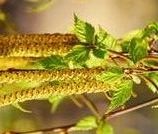Himalayan Birch
(Betula alnoides)

Description
Betula alnoides is a species of birch that can be found in natural condition of such countries as Bangladesh, Bhutan, Cambodia, China, India, Laos, Myanmar, Nepal, Thailand and Vietnam at an elevation of 300–2,100 metres (980–6,890 ft) and higher in some cases (up to 2,700 metres (8,900 ft)). The southernmost of all known birch species, whose natural range reaches approximately 12° N in Cardamom Mountains, Cambodia. The plant is 30 metres (98 ft) tall with white coloured branches. It has 1.5–3 centimetres (0.59–1.18 in) long petioles and has a 2.5–5.5 centimetres (0.98–2.17 in) long leaf blade that is lanceolate, ovate, papery, and even elliptic. The female inflorescences a pendulous and cylindric raceme, that, by time it matures, reaches a diameter of 5–10 centimetres (2.0–3.9 in) by 4–6 millimetres (0.16–0.24 in). The peduncle is 2–3 millimetres (0.079–0.118 in) long while the diameter of the bracts is only 3 millimetres (0.12 in). The seeds are ripe from March to May and are 1.5–2 millimetres (0.059–0.079 in) long while the flowers bloom from October to January. Betula alnoides inner bark is edible and is used for making cakes and bread. It is also considered to be an antidote against snakebites and is used to treat dislocated bones.
Taxonomic tree:







